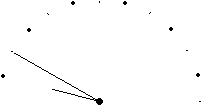 *
*
Purpose
To be used in electronic displays (on computer screens),
and in mechanical displays with the bottom half of the circle described by the
clock hands being hidden by other layers of a display.
The idea for this clock was inspired by the logo of a bookstore which
consisted of a half a sun sitting on a ledge,
with 2 layers of rays eminating from it.
The background layer was static, and the foreground rotating.
It seemed to me that something should be done with the rear layer.
Hence what you see here.
Specifications
This clock uses diameters for hands instead of radii.
The extra radius of the hand is hidden, except at 12 o'clock, and on the hour.
The hands are diameters such that the clockwork continues forward at all times.
Using radii and a half circle would require the movement to reverse or reset itself every twelve hours.
The clock is divided into thirteen segments instead of twelve such that when it is 12 o'clock,
or on the hour, only one end of the hand points to a number.
Because there are thirteen divisions in half the circle; as opposed to the 6 of a conventional clock;
the mechanism will need to run at 13/6 the speed of a normal clock.
This is also useful for electronic display clocks (ie; computer screens).
Some prefer analog clocks, but they take up too much room.
A semi-circular clock solves that problem.
But, it is still a good idea for an electronic display to divide the semi-circle into 13 segments,
as opposed to twelve; there will be no overlap problem and this avoids a
profusion of formats for users to acclimate to.
This is because the 180 degrees of a semi-circle are much more neatly divided into
thirteen 15 degree segments, than twelve 16.36(bar) segments.
Also, this allows for a standard, and continuity.
One revolution of the hour hand, corresponds to a day.
Matters of Aesthetics
The mechanism must also step the hour hand, as opposed to the normal sweeping.
Otherwise 1 o'clock shall be indicated by the hour hand pointing to nothing on the right;
minutes 1-4 shall by necessity be indicated as such.
The minute hand may sweep or step, but stepping would provide symmetry.
The clock can also be rotated such that the flat edge could lie against a
vertical surface on the right or left.
It could also be made such that the flat edge is on the top.
The flat edge matches up well against that of the screen, or a window.
Though, in an electronic display clock, there is no need for the hands to be diameters;
the computer has no problem resetting the motion from the beginning;
it may be as such for continuity.
The clock should always be numbered clockwise, with the first increment being 1.
License
I have yet to uncover evidence of a similar idea anywhere,
but do not wish to attain exclusive rights either.
I therefore grant use as the intentions are outlined in the
Perl Artistic License. All that I ask is to be given some credit
in any apporpriate documentation, and to be notified of your use,
belg4mit@mit.edu
NOTE:
For simplicity and to conserve bandwith, the example moves in units of five.
 *
*
 *
*